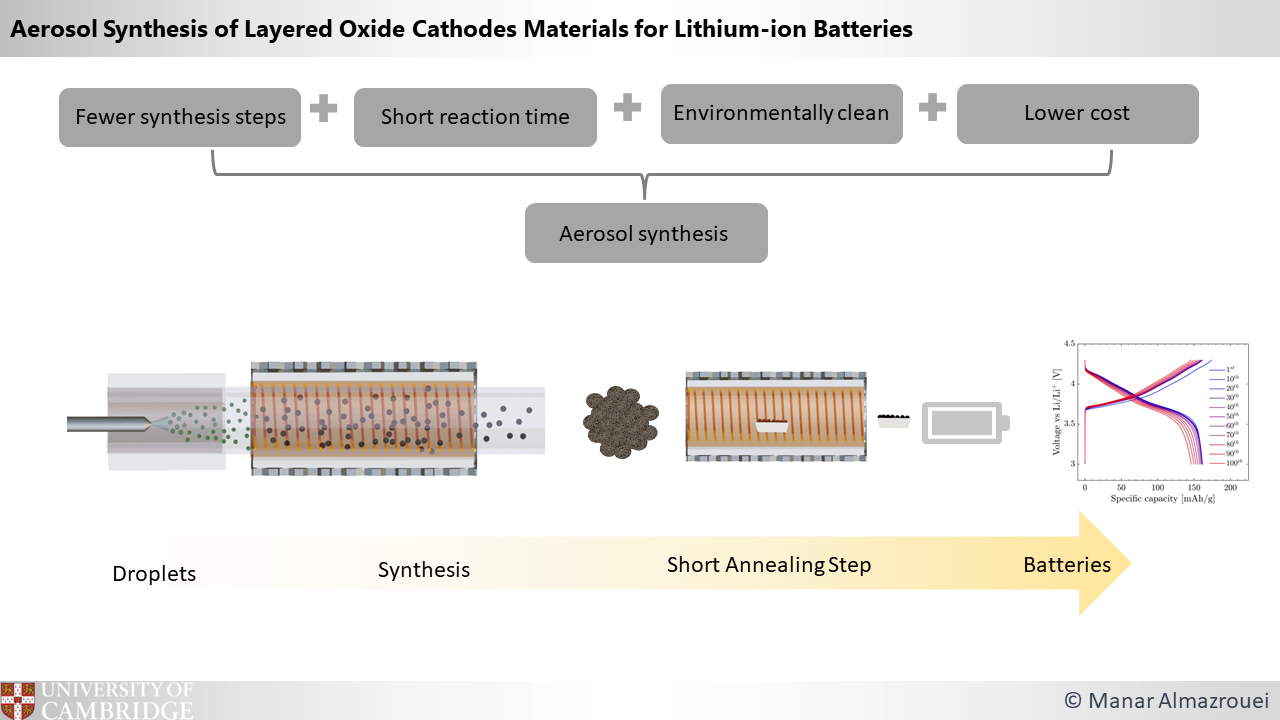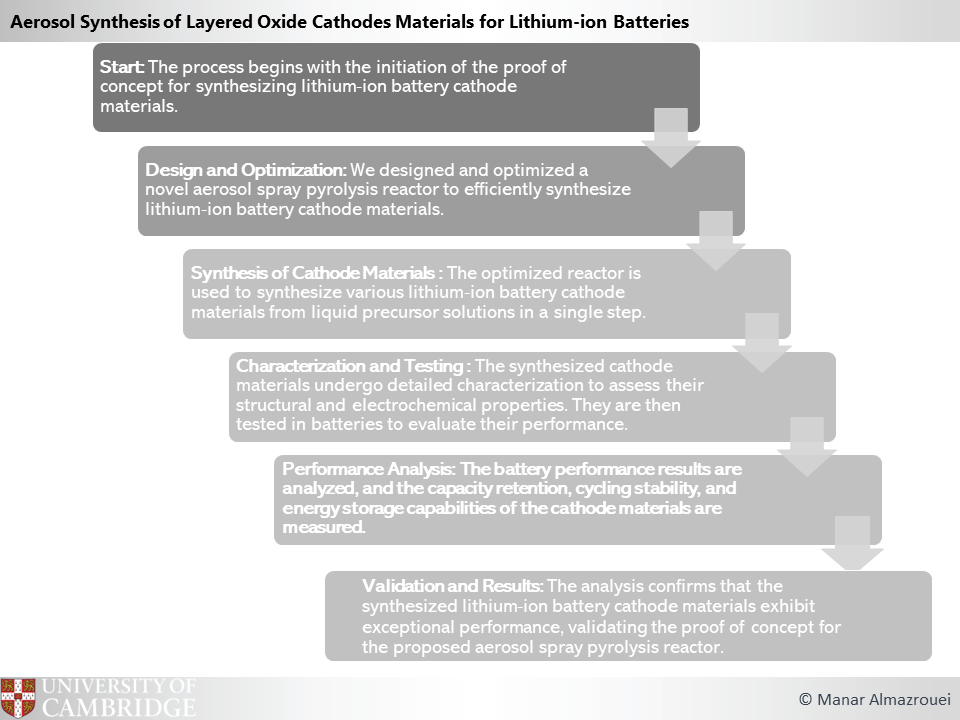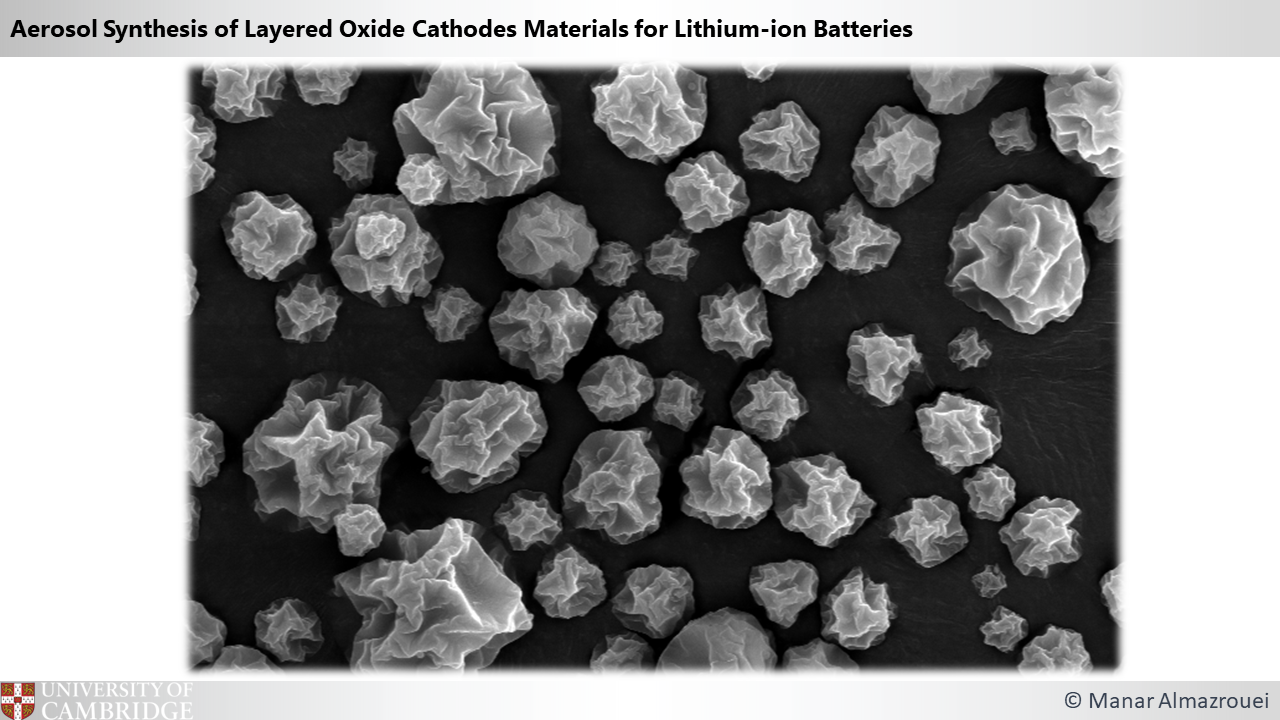In this interview, AZoCleantech speaks with University of Cambridge graduate Manar Almazrouei about her project on advancing lithium-ion battery (LIB) cathode material synthesis through innovative aerosol-based techniques, streamlining production, and promoting environmental sustainability.
Can you please introduce yourself and your professional background?
My name is Manar Almazrouei, and I obtained a Ph.D. in Engineering within the Energy Group at the University of Cambridge in 2023. My research centers on the aerosol synthesis of cathode materials for lithium-ion batteries.
Throughout my doctoral journey, I have undertaken the role of designing innovative reactors aimed at enhancing the efficiency of battery material production. These innovative reactors hold the promise of substantially reducing synthesis durations and refining the overall battery material manufacturing process. Through the streamlining of this synthesis procedure, my work contributes to the progression of sustainable energy storage solutions.
With a Bachelor's degree in Renewable Energy Engineering and a Master's degree in Mechanical Engineering, specializing in biofuels, my research background has been centered around green energy solutions aimed at making a positive impact on the world.

Image Credit: KanawatTH/Shutterstock.com
You have applied to this year’s Prototypes For Humanity project, where pioneers in the scientific field are able to showcase their innovations that have the power to change the world. Please can you introduce the project that you have spearheaded?
The project focuses on advancing lithium-ion battery (LIB) cathode material synthesis through innovative aerosol-based techniques, streamlining production, and promoting environmental sustainability.
The Innovative Reactor offers a streamlined and efficient approach to cathode material synthesis by utilizing a single-step process from liquid precursors. Not only does it significantly reduce production time and resources, but it also ensures a homogeneous composition in a remarkably short residence time.
A key advantage lies in its scalability, making it adaptable for both small and large-scale manufacturing while maintaining a continuous operation. Moreover, this innovation is environmentally friendly, producing zero chemical waste during synthesis, which aligns with the global push for sustainability.

Image Credit: Manar Almazrouei
By simplifying and enhancing the cathode material production process, this reactor holds the potential to drive advancements in energy storage technologies, resulting in more efficient and eco-friendly lithium-ion batteries that play a pivotal role in the transition to cleaner and greener energy solutions.
What is the key problem you are trying to address with the Innovative Spray Pyrolysis Reactor? How is it helping to advance battery technologies?
The problem being addressed is the urgent need for efficient and sustainable energy storage solutions due to the increasing global population and rising energy demands, which have led to the exacerbation of climate change through the reliance on fossil fuels.
Lithium-ion batteries (LIBs) play a pivotal role in the efficient storage of renewable energy, particularly in applications like electric vehicles and renewable energy storage.
The challenge lies in enhancing the performance of cathode materials, a critical component of LIBs, through improved synthesis methods and conditions. This not only boosts battery performance but also reduces manufacturing costs, making LIBs more competitive and better suited to meet the growing demands for energy storage solutions, thereby supporting the global transition towards sustainability.
How does your project address the challenges of efficient and sustainable energy storage in the context of a growing global population and rising energy demands?
The project will have a profound impact by advancing battery technology, thereby contributing to a more sustainable and accessible energy future. This impact is of paramount importance because it addresses critical global challenges.
Firstly, it aids in reducing our carbon footprint and mitigating climate change by promoting the adoption of clean energy sources. Secondly, it enhances the accessibility and affordability of renewable energy, reducing dependence on finite fossil fuels. Thirdly, it fosters technological advancements across industries, leading to economic growth and improved quality of life. Finally, by bridging the gap between academia and industry, my work facilitates the practical application of research knowledge, ensuring that innovative solutions reach the broader society, benefiting us all.
Can you elaborate on the workings of the Innovative Spray Pyrolysis Reactor? How does it differ from existing cathode material synthesis processes?
The Innovative Spray Pyrolysis Reactor is a specialized equipment used for the synthesis of cathode materials in the field of battery technology and other applications that require the production of finely controlled particle materials. It differs from existing cathode material synthesis processes primarily in its approach to particle generation and collection.
In the reactor, the precursor solution is atomized into fine droplets, which are then introduced into a high-temperature pyrolysis chamber. Key innovations include the design of a preheating zone with a radial inflow to prevent precursor deposition on internal walls, maximizing production rates, and an enhanced particle collection system to maximize the collection rate of synthesized nanoparticles. These features collectively contribute to the overall efficiency and reliability of the reactor in producing high-quality cathode materials.

Image Credit: Manar Almazrouei
In what ways does your project push the boundaries of current lithium-ion battery technology?
The Innovative Spray Pyrolysis Reactor introduces a novel approach to cathode material synthesis. Using aerosol-based techniques, our reactor streamlines the production process, reducing both time and resource consumption.
This innovation allows for the creation of cathode materials with a highly homogeneous composition in a remarkably short residence time. This level of efficiency is not commonly achieved in traditional synthesis methods.
The streamlined production process not only saves time but also reduces manufacturing costs. This cost reduction can make lithium-ion batteries more competitive in the market, further promoting their adoption and helping to address the challenge of rising energy demands.

Image Credit: Manar Almazrouei
How do you see your project contributing to the transition towards renewable energy sources and mitigating climate change?
Lithium-ion batteries are a key enabler of renewable energy integration, storing excess energy from intermittent sources like wind and solar power. By improving the efficiency and performance of cathode materials, my project ensures that energy storage solutions are more effective, reliable, and capable of storing renewable energy for longer durations.
The Innovative Spray Pyrolysis Reactor's environmentally friendly approach, which produces zero chemical waste during synthesis, aligns with sustainability goals. It reduces the environmental impact associated with battery material production, further contributing to the overall reduction in carbon footprint.
What are the potential industrial applications of your synthesized cathode materials?
Improved cathode materials can significantly enhance the performance and energy density of lithium-ion batteries used in electric vehicles. This leads to longer driving ranges, faster charging times, and increased overall efficiency, which is critical for the widespread adoption of EVs.
These cathode materials can be utilized in energy storage systems for capturing and storing renewable energy from sources like wind and solar power. This contributes to the stability and reliability of renewable energy grids by providing a steady source of electricity when the sun isn't shining or the wind isn't blowing.
How scalable is the Innovative Spray Pyrolysis Reactor, and what implications does this have for mass production?
The Innovative Spray Pyrolysis Reactor is highly scalable, which makes it well-suited for mass production of cathode materials for lithium-ion batteries and other applications. Scalability is a crucial feature of this innovation, and it has several implications for mass production:
- The scalability of the reactor allows for the efficient production of cathode materials in large quantities. This can significantly reduce the cost per unit of material produced, making it more economically viable for mass production.
- As the demand for lithium-ion batteries continues to grow, particularly in electric vehicles and renewable energy storage, the ability to scale up production is essential. The Innovative Spray Pyrolysis Reactor can adapt to different production volumes, ensuring that it can meet the increasing demand for high-quality cathode materials.
- The reactor's scalability means it can be used for both small-scale and large-scale manufacturing. This flexibility is advantageous for various industries, from small startups to large battery manufacturers, allowing them to tailor production to their specific needs.
Could you share any plans for future collaborations or partnerships to advance this technology?
Collaborating with battery manufacturers and technology companies is a logical step to bring this innovation to market. Partnering with industry leaders can facilitate the integration of the reactor technology into existing production processes and help scale up production for commercial use.
Partnering with other research institutions, both nationally and internationally, can lead to further advancements in the technology. Sharing knowledge, resources, and expertise can accelerate research and development efforts in the field of energy storage and battery materials.
Collaboration with government agencies, such as energy departments and environmental agencies, can help secure funding, regulatory support, and incentives for the development and adoption of environmentally friendly and efficient battery technologies.
Seeking investments from venture capitalists, angel investors, and funding agencies can provide the necessary financial resources to further develop and commercialize the Innovative Spray Pyrolysis Reactor and associated technologies.
Where do you see the impact of your project in the next 5-10 years, both in the scientific community and in practical applications?
The Innovative Spray Pyrolysis Reactor will likely become a valuable tool in battery research laboratories worldwide. Its innovative approach to cathode material synthesis will inspire further research into aerosol-based techniques and their applications in energy storage.
The reactor's technology is expected to generate a wealth of research papers and studies, significantly enriching the scientific discourse on efficient and sustainable energy storage solutions.
This innovation will also pave the way for collaborations among research institutions, universities, and industry partners. Such partnerships will be instrumental in sharing knowledge and expertise in battery technology, thereby driving further innovation and breakthroughs.
In the commercial sector, the Innovative Spray Pyrolysis Reactor is anticipated to be a game-changer in the production processes of lithium-ion batteries. Battery manufacturers are likely to embrace this technology, aiming to optimize production efficiency and reduce costs.
About Manar Almazrouei
 Manar is currently in the final stage of her Ph.D. program in Engineering within the Energy Group at the University of Cambridge. Her research centers on the aerosol synthesis of cathode materials for lithium-ion batteries. Throughout her doctoral journey, she has undertaken the role of designing innovative reactors aimed at enhancing the efficiency of battery material production. These innovative reactors hold the promise of substantially reducing synthesis durations and refining the overall battery material manufacturing process. Through the streamlining of this synthesis procedure, her work contributes to the progression of sustainable energy storage solutions.
Manar is currently in the final stage of her Ph.D. program in Engineering within the Energy Group at the University of Cambridge. Her research centers on the aerosol synthesis of cathode materials for lithium-ion batteries. Throughout her doctoral journey, she has undertaken the role of designing innovative reactors aimed at enhancing the efficiency of battery material production. These innovative reactors hold the promise of substantially reducing synthesis durations and refining the overall battery material manufacturing process. Through the streamlining of this synthesis procedure, her work contributes to the progression of sustainable energy storage solutions.
Disclaimer: The views expressed here are those of the interviewee and do not necessarily represent the views of AZoM.com Limited (T/A) AZoNetwork, the owner and operator of this website. This disclaimer forms part of the Terms and Conditions of use of this website.